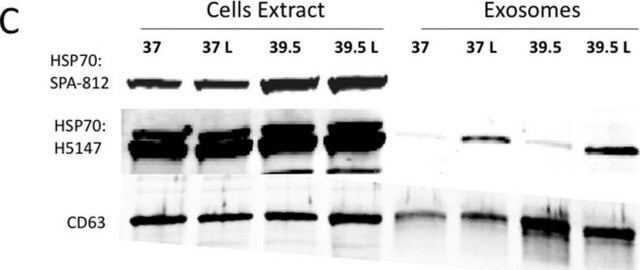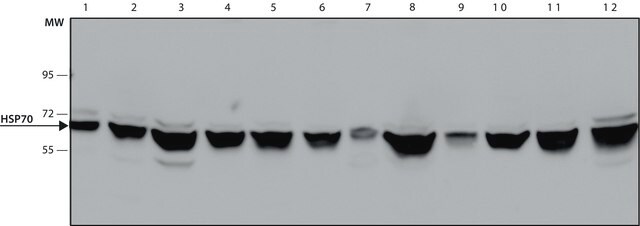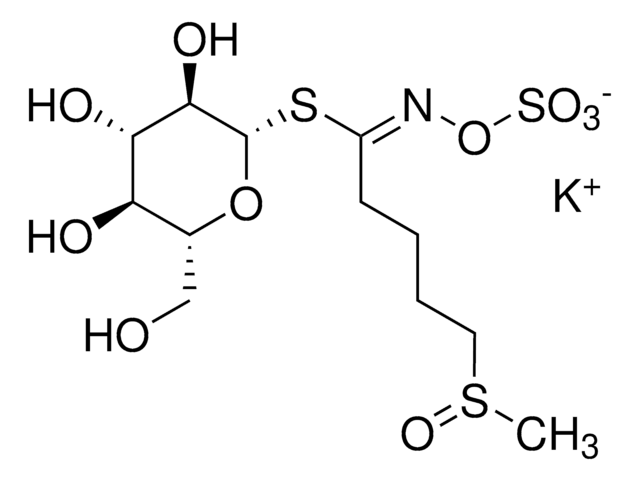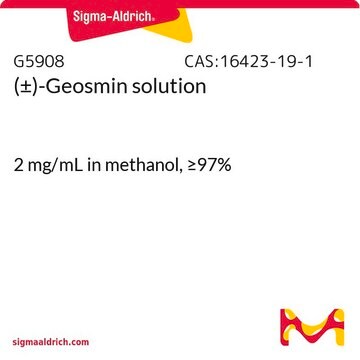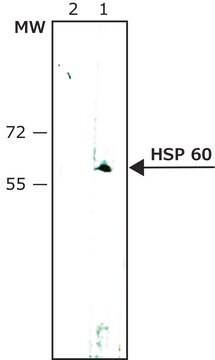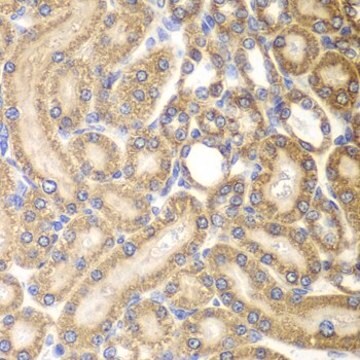추천 제품
생물학적 소스
mouse
Quality Level
결합
unconjugated
항체 형태
ascites fluid
항체 생산 유형
primary antibodies
클론
LK2, monoclonal
분자량
antigen 60 kDa
포함
15 mM sodium azide
종 반응성
spinach, chicken, E. coli, helminth, rat, human
기술
electron microscopy: suitable
immunohistochemistry (formalin-fixed, paraffin-embedded sections): suitable
indirect ELISA: suitable
western blot: 1:100 using cultured human foreskin fibroblast extract
동형
IgG1
UniProt 수납 번호
배송 상태
dry ice
저장 온도
−20°C
타겟 번역 후 변형
unmodified
유전자 정보
human ... HSPD1(3329)
rat ... Hspd1(63868)
일반 설명
Monoclonal Anti-Heat Shock Protein 60 (HSP60), clone LK2, recognizes an epitope located between amino acid residues 383-419 of the human (corresponding to a.a. residues 356-393 of the mycobacterial) HSP60. The antibody is reactive against the mammalian (e.g., human, rat), avian (e.g., chicken), bacterial (e.g., E. coli), helminths and spinach HSP60. In immunoblotting, the antibody may label additional bands at approx. 38 and 97 kDa. It is reactive with both the constitutive and the inducible HSP60. It shows a raised level of staining in immunohistochemistry of formalin-fixed, paraffin-embedded synovial membranes taken from patients with juvenile chronic arthritis.
Monoclonal anti-Heat Shock Protein 60 (mouse IgG1 isotype) is derived from the LK2 hybridoma produced by the fusion of mouse myeloma cells and splenocytes from BALB/c mice immunized with recombinant human heat shock protein 60.
면역원
recombinant human heat shock protein 60 (HSP60).
애플리케이션
Monoclonal Anti-Heat Shock Protein 60 antibody produced in mouse has been used in:western blotting, immunocytochemistry, enzyme linked immuno sorbent assay (ELISA) ,immunoblotting
생화학적/생리학적 작용
A wide variety of environmental perturbations, such as a sudden increase in temperature, induce cells to rapidly synthesize a group of polypeptides known as the heat shock (stress) proteins. The 60 kDa HSP family (HSP60) which retained a uniquely high level of sequence conservation during evolution is a focus of interest as a potential antigen in a number of autoimmune diseases. Abnormal immune reactivity involving HSP60 has also been implicated in the pathogenesis of schizophrenia. In human arthritis and experimentally-induced arthritis in animals, disease development was seen to coincide with development of immune reactivity directed against not only bacterial HSP60, but also against its mammalian homologue. A human mitochondrial protein, originally designated P1, has been described as the human homologue of the bacterial HSP60, and >45% of the protein has sequence identity with its bacterial homologue (groEL, HSP65).
면책조항
Unless otherwise stated in our catalog or other company documentation accompanying the product(s), our products are intended for research use only and are not to be used for any other purpose, which includes but is not limited to, unauthorized commercial uses, in vitro diagnostic uses, ex vivo or in vivo therapeutic uses or any type of consumption or application to humans or animals.
적합한 제품을 찾을 수 없으신가요?
당사의 제품 선택기 도구.을(를) 시도해 보세요.
Storage Class Code
10 - Combustible liquids
WGK
nwg
Flash Point (°F)
Not applicable
Flash Point (°C)
Not applicable
Inge Kühl et al.
Mitochondrion, 12(3), 381-390 (2012-02-22)
Complexes III and IV of the mitochondrial respiratory chain contain a few key subunits encoded by the mitochondrial genome. In Saccharomyces cerevisiae, fifteen mRNA-specific translational activators control mitochondrial translation, of which five are conserved in Schizosaccharomyces pombe. These include homologs
OPA1 haploinsufficiency induces a BNIP3-dependent decrease in mitophagy in neurons: relevance to Dominant Optic Atrophy
Moulis MF, et al.
Journal of Neurochemistry, 140(3), 485-494 (2017)
Ann M Fallon et al.
In vitro cellular & developmental biology. Animal, 44(8-9), 351-356 (2008-07-16)
The Aedes albopictus Aa23 cell line, which is persistently infected with Wolbachia pipientis strain wAlbB, tends to grow as aggregated clusters of cells that are difficult to disperse for conventional quantification based on cell number. We used A. albopictus C7-10
Malgorzata Milewska et al.
Journal of neurochemistry, 111(4), 1022-1030 (2009-09-22)
Hereditary spastic paraplegia describes a group of neurodegenerative diseases characterized by lower limb progressive weakness and spasticity. Troyer syndrome is an autosomal recessive form of hereditary spastic paraplegia caused by a frameshift mutation (1110delA) in the SPG20 gene encoding spartin
A genome wide study in fission yeast reveals nine PPR proteins that regulate mitochondrial gene expression
Kuhl I, et al.
Nucleic Acids Research, 39(18), 8029-8041 (2011)
자사의 과학자팀은 생명 과학, 재료 과학, 화학 합성, 크로마토그래피, 분석 및 기타 많은 영역을 포함한 모든 과학 분야에 경험이 있습니다..
고객지원팀으로 연락바랍니다.